Posted by Elena del Valle on May 6, 2013

A still image from the Es Fácil Ser Hombre ad campaign – click to enlarge
Video, photos: Formulatin
Beer maker Tecate wants to win over Spanish speaking and bilingual men 21 years of age and older in the United States and Mexico with Es Fácil Ser Hombre, its most recent Spanish language ad campaign. The company’s three 30-second TV spots, three 60-second radio spot and out-of-home ads will run across what its marketing executives consider its key Spanish language markets in the United States and Mexico.
The TV spots, filmed and produced in Mexico City, were completed in late 2012 and the radio spots in early 2013 by a team led by Felix Palau, vice president of Marketing for Tecate.
In the United States, the campaign will air in California, Texas, New Mexico, Arizona, and Illinois. Handled by MediaVest MV42, the media buy includes Univision, Telemundo, Unimas, Galavision, Estrella TV, Fox Deportes, ESPN Deportes, Univision Deportes, Azteca, LA TV and Nuvo TV. Scroll down to watch an ad from the campaign in Spanish.

A still image from the Es Fácil Ser Hombre ad campaign
“It’s important for us to ensure that our brand communication efforts in the U.S. and in Mexico are aligned. However, because we understand that there are nuances between Hispanic men living in both countries, we tested our Mexico-created spots in our key U.S. markets. We’re very happy with the positive feedback we received from consumers in these focus groups, and are certain that the inherent wit and humor in the spots is relevant to all Hispanic men con carácter,” said Palau by email.
The company launched the TV and radio spots April 22 and the OOH began rolling out April 29. The campaign is expected to run through the summer and into early fall. Company representatives declined to disclose the campaign budget or the number of staff involved in the project.
The campaign was created by Olabuenaga Chemistri, Tecate’s Mexico City advertising agency of record. The staff designed the campaign around “real-life situations” they hope men relate to, showcasing “how they use their ingenuity, wit and humor to resolve these without losing their carácter.”
In the first 30 second spot titled Boda (Wedding), the bride throws the bouquet and is confused when it bounces back. After a few tries the camera turns to reveal a man jumping in to throw the flowers back to the bride. The spot ends with the narrator saying “A man prefers an uncomplicated life.”
Llaves (Keys), the second spot in the campaign, shows a man coming home late from a night out. When he tries to open the door he realizes he does not have his keys and uses his cell phone to call for help. A group of mariachis show up to serenade his wife, which leads to her opening the door and letting him in without knowing he had forgotten his keys and without reprimanding him for his late arrival. The narrator closes the spot with “A man knows there is always another way in.”
The third and last spot, Pétalos (Petals), shows a woman coming home and finding a path of rose petals and candles that lead her down the hall to the refrigerator. She hears her husband calling from another room: “Honey, since you’re already in the kitchen, could you please bring me a Tecate?” The narrator finishes by saying: “A man knows how to get what he wants.”
The Spanish-language radio and out-of-home were designed to have the same tone as the TV ads. The first of the three 60 second radio spots, Pregunta (Question), opens with a woman pressing her husband to ask for directions when they find themselves lost while driving. She’s surprised when the man agrees, and even more so when her husband pulls over to inquire about the score of the soccer game. The spot ends with the narrator saying, “A man only asks questions when it’s necessary.”

A still image from the Es Fácil Ser Hombre ad campaign
In the second spot, Teléfono (Telephone), a man tells his male friend he needs to leave the bar to go home, and is chastised for wanting to leave just to please his wife. The main character calls home to check in, and upon hearing his wife’s angry response he pretends to be a pizza delivery guy, hangs up the phone and decides to stay at the bar. The narrator finishes the spot saying: “A man knows how to test the waters.”
The third radio spot, Película (Movie), begins with a man asking his girlfriend if she’d like to stay in for a movie night at home. When the woman states she loves the idea, the man says: “That’s great! I do want to go out with my friends so I’ll see you later!” A narrator closes the spot with, “A man takes advantage of any oversight.”
The first OOH creative features a puppy with the word anzuelo (hook), while the second one shows a pair of sunglasses at the beach, reflecting a woman and the word escáner (scanner) written underneath. The ad creators tied radio and OOH to the campaign by using the brand tag line Es Fácil Ser Hombre. Con Carácter.
“For the past few years, we have been building upon Tecate’s values, which include carácter, masculinity, and ingenuity, and are excited to see those traits exemplified in this campaign,” said Palau. “Since the ads are running in Mexico and the U.S. to ensure consumers on both sides of the border are being exposed to the same messaging, we had to ensure the scenarios presented were relatable to all Hispanic men, not just Mexicans. We are proud of the end result and hope consumers enjoy the light-hearted nature of this campaign.”
Tecate is a brand of Heineken, USA Inc., a leading upscale beer importer and a subsidiary of Heineken International BV. In addition to Tecate, Heineken USA imports the Dos Equis Franchise, Sol, Indio, Carta Blanca and Bohemia brands from Mexico.
Comments:
Filed Under: Video
Posted by Elena del Valle on March 22, 2013

Raymond Santana, one of The Central Park Five
Video and photos: Florentine Films, Rahoul Ghose
In 1989, a white woman was found raped, beaten, nearly naked and near dead in Central Park in New York City. Weeks later five teenage boys who became known as The Central Park Five, Antron McCray, Kevin Richardson, Raymond Santana, Kharey Wise and Yusef Salaam, were arrested for the crime after they confessed following hours alone with police and aggressive interrogation. In 2002, a judge overturned their convictions based on DNA evidence and a confession from an alleged murderer and serial killer. After their exoneration The Central Park men sued the city, the police and the prosecutors. Scroll down to watch a video clip.
The Central Park Five, a 118-minute documentary released November 2012 and scheduled to air on PBS April 16 and become available online April 17, features the story from the perspective of the young men who were teenagers at the time of the crime. In a slow paced, depressing trip back in time featuring interviews with the men, their relatives and a variety of individuals but excluding anyone from the city, the police or prosecutors who declined to appear in the film or present their point of view, the filmmakers take viewers to 1989 New York City. The film will be available in Spanish on the secondary audio channel.
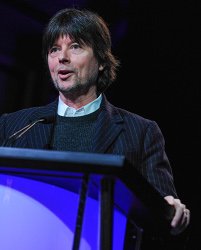
Filmmaker Ken Burns
Others interviewed include New York City Mayors Ed Koch and David Dinkins; Jim Dwyer, Natalie Byfield and LynNell Hancock, journalists; Reverend Calvin Butts; and Craig Steven Wilder, an historian. The film executives and the film were in the news recently after they won a legal victory against New York City representatives who wanted access to film outtakes for use in their defense in the civil suit the young men brought against the city.
The filmmakers were Ken Burns, David McMahon and Sarah Burns. The film was edited by Michael Levine. The cinematography was by Buddy Squires with Anthony Savini with original music by Doug Wamble. Funding for the film was provided by The Atlantic Philanthropies, Corporation for Public Broadcasting, members of The Better Angels Society, including and Bobby and Polly Stein, and PBS.
Posted by Elena del Valle on January 28, 2013
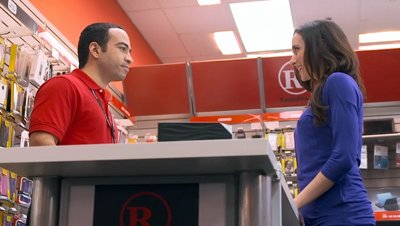
Radio Shack Spanish language TV ad targets 18-34 tech savvy shoppers
Photos, video: Radio Shack, Wing
This month Radio Shack with the help of Wing, its Hispanic market agency, ran four new Spanish-language TV spots hoping to attract Spanish speaking men and women aged 18 to 34 “that are tech savvy and actively upgrade their products and choose brands based on looks and features, not durability.” The customer the ads are for, according to a spokesperson, “wants to be the first one to have the newest, coolest products and aspires to be a trendsetter.” Scroll down to watch two ads in Spanish.
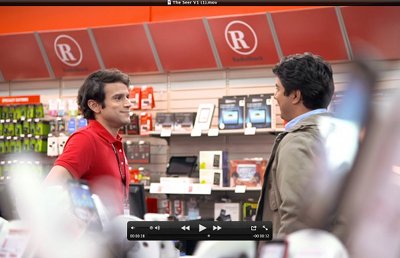
The ads were produced in Westchester, New York
Produced for less than one million dollars in Westchester, New York in December 2012 from English language originals the ads strive to convey the concept of “matching technology to your life,” to communicate how fast technology is changing and “show that Radio Shack is the personal technology store that knows their consumer,” and portray the store clerk as a knowledgeable hero.
The ads ran until Saturday January 26, 2013 in ESPN Desportes, Univision, Galavision, Telefutura, MUN2, and Telemundo. Online, they ran as ad pre-roll before editorial videos on Radio Shack’s YouTube page and Hulu. The Sad Girl ad (below), created to promote the company’s Accessory Central store, focuses only on the range of cases available to the consumer. The Seer ad (below), featuring various accessories available at Accessory Central designed to enhance the consumer’s music experience, should air again between February 24 and March 16 of this year. Team members for the project include: Renata Florio, chief creative officer; Alvaro Naddeo, art director; Facundo Paglia, copywriter; Tania Salter and Keyla Hernandez, producers; Shooters, Inc. as the production company; and Steve Williams, director.
Comments:
Filed Under: Video
Posted by Elena del Valle on November 5, 2012

Kevin O’Shea, brand manager, Gold Eagle Co.
Photo, video: Gold Eagle Co.
Gold Eagle Company released Chainsaw Psycho, a national television and online ad, a spoof of the 1974 cult chainsaw massacre movie, to promote its brand of fuel-system revitalizers, Start Your Engines! Shot in Conestogo, Canada and produced in one week by five people under the supervision of Matthew Ninaber, a Poptent community member, and his team at High-Rise Studio in Ontario, the ad was designed for a target audience “not limited to but mostly for men” and “people with a sense of humour.” Scroll down to watch the ad video.
“We wanted to do something entirely different with this TV spot to illustrate how Start Your Engines! works and overemphasize its immediate solution to those untimely life moments when your small-engine equipment malfunctions,” said Kevin O’Shea, brand manager, Gold Eagle Co. “This TV spot also marks an exciting new direction for Gold Eagle’s marketing approach.”
In the Halloween-themed spot a chainsaw killer is about to take his next victim only to discover his chainsaw won’t start. The victim, lying on the floor awaiting his doom, gives the killer advice for small engine trouble shooting and offers the killer a bottle of Start Your Engines! The spot concludes with the victim extolling the benefits of the product just before the chainsaw starts.
The commercial appeared on YouTube and aired on national television in October 2012 on HGTV shows, Property Brothers, House Hunters International and Yard Crashers, and the DIY network on Yardcore, House Crashers and The Vanilla Ice Project. Marketing executives for the company estimate landing page traffic went from nothing to 692 views between September 1 and October 28 of this year. YouTube analytics, a spokesperson shared, indicate that viewership of the spot was just under 23,000 views. Gold Eagle Co. is a privately held Chicago based maker of engine maintenance fluids and fuel additives.
Posted by Elena del Valle on September 27, 2012
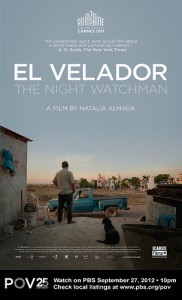
El Velador film poster – click to enlarge
Video, photos: El Velador (The Night Watchman)
Mexico’s drug war is said to have resulted in 50,000 violent deaths from the last few years to date. One place where the dead are remembered is in a cemetery in Culiacan, Mexico where many of the country’s drug lords are said to be buried. El Velador (The Night Watchman), a 72-minute 2011 documentary about a slice of everyday life with the night watchman who looks after the cemetery and its elaborate mausoleums, is airing in the United States on PBS and as part of a national museum tour including Wexner Center for the Arts, Columbus, Ohio; Walker Art Center, Minneapolis; Nelson-Atkins Museum of Art, Kansas City; and Yerba Buena Center, San Francisco. Scroll down to watch a video clip of the documentary.
“Drugs are trafficked and consumed around the world and yet Mexico is the battlefield of the war on drugs. I hope El Velador is a film that will touch audiences and help us understand what it means to live in a situation of violence and what socio-economic conditions lead to violence,” said Natalia Almada, director of the film, by email in response to a question about why she filmed the documentary and how she believes it is relevant to United States audiences today.

A scene from El Velador
El Velador will stream on the POV website, www.pbs.org.pov/, from September 28 to December 20, 2012. Details about the museum tour can be found at http://www.icarusfilms.com/playdates.html#vela and information about the film DVD is listed at http://www.icarusfilms.com/new2011/vela.html
The film begins inside the watchman’s truck with a view of the cemetery through a dirty and fogged up windshield reminiscent perhaps of the public’s view of the war itself. With an introspective slow tone the film is notably dark during the evening scenes, featuring background television and radio news and little Spanish language dialogue with English language subtitles. The modest, poor looking construction workers with torn shoes present a contrast to the expensive structures they build for the newly departed. Also notable are the luxury cars and the large colorful banners each with a photo and years of birth and death commemorating of the deceased.
“When I first went to film at the cemetery where the film takes place in July 2009, there were four new mausoleums under construction and a tractor was digging up the dirt for a new hole to bury another 300 bodies,” said Almada in a press release. “The ‘progress’ of the cemetery mirrored the violence that was spiraling out of control.”

Natalia Almada, director, El Velador
“In making El Velador, I hoped to gain entry to that world of violence. To experience what it means to live in that context, to work, to mourn, to sweat, to sleep there. I wanted to pause, and I wanted others to pause and be suspended in that place and moment where violence has just occurred and where violence is imminent. By restricting myself to one small corner of the cemetery, I came to realize that it is only by paying attention to the details that we can begin to fathom the complexity of violence,” said Almada in her filmmaker statement (she referred queries to the POV and film websites).
The film, co-produced by POV (Point of View) American Documentary Inc. and Natalia Almada (Al Otro Lado, 2006; El General, 2010), had a $300,000 budget. Almada, an award-winning director originally from the state of Sinaloa in northern Mexico, was also producer, director of photography and editor of the documentary. She received the 2009 Sundance Documentary Directing Award for her film about her great-grandfather, Mexican president Plutarco Elías Calles.
POV (Point of View) is one of television’s longest-running showcase for independent non-fiction films on PBS. Since 1988, POV has presented 300 films to public television audiences across the country.
Posted by Elena del Valle on August 1, 2012
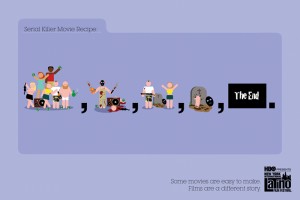
New York International Latino Film Festival 2012 Serial Killer Movie Recipe ad – click to enlarge
Video, photos: Wing
Hoping to reach New York City Urbanites between the ages of 25 and 45 the 2012 HBO New York International Latino Film Festival (NYILFF) with the pro bono help of Wing, a marketing communications agency, launched a print and television ad campaign aimed at broadening the appeal of the NYILFF, running August 13-19, 2012 in New York City. Scroll down to watch a 30-second video ad for the 2012 campaign.
“The overall reach of the campaign has been far. We have been picked up by a great deal of pubs including Creativity, TrendHunter, Ihaveanidea.com, Latinspots, Ads of the World, among others,” said Marieugenia Cardenas, assistant account executive, Wing.
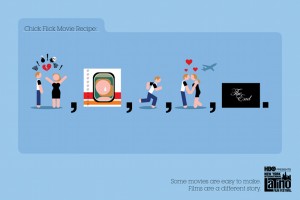
New York International Latino Film Festival 2012 Chick Flick Movie Recipe ad – click to enlarge
Thirteen people under the supervision of Tania Salter, vice president and head of Production at Wing, worked on the campaign this year producing six print ads and two television spots. Some ads ran as public service announcements and some as paid advertisements in theaters. To date ads have aired on NBC, Telemundo, and Clearview Cinemas.
The campaign, in English and Spanish, pokes fun at Hollywood cliches, relying on the tagline “Some movies are easy to make. Films are a different story.” The stereotypical Hollywood movie types the campaign makes fun of are: Sports Comeback, Serial Killer, Chick Flick, Buddy Cop and Alien Invasion themes.
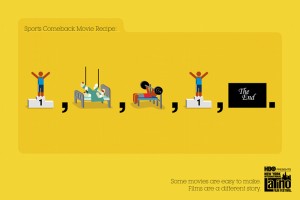
New York International Latino Film Festival 2012 Sports Comeback Movie Recipe ad – click to enlarge
“We were trying to attract people who normally don’t go to this festival (who don’t necessarily speak Spanish) while at the same time not alienating the core audience (who does speak Spanish),” said Cardenas.
This is the second year the festival is partnering with Wing. Last year the campaign poked fun at Hollywood movies for casting Latinos only in roles like maids, gardeners, and fruit stand vendors (see With video NY Latino Film Festival ad campaign makes fun of Hollywood cliches).
According to promotional materials, the campaign went viral through earned media, becoming the top story on Trendhunter and Buzzfeed, and garnered 29 million impressions. Dating back to 1999, the NYILFF strives to showcase the work of emerging Latino filmmakers in the United States and Latin America.
Posted by Elena del Valle on May 16, 2012

Ron Bacardi de Maestros de Ron, Vintage, MMXII – click to enlarge
Video, photos: Bacardi
Earlier this year Bacardi, the international rum making giant, celebrated 150 years of operations with displays, parties, and a family reunion. Although the top selling Bacardi product in the United States is Grey Goose to mark the occasion the company announced Ron Bacardi de Maestros de Ron, Vintage, MMXII, a limited edition Bacardi blend the combined effort of eight Bacardi family members and former rum masters (maestros de ron). Scroll to watch video about Ron Bacardi de Maestros de Ron, Vintage, MMXII.
A “blend of the finest rums laid to rest in oak barrels over the last 20 years and finished in 60-year-old Cognac barrels,” the liquid, bottled in a hand-blown crystal decanter made in Mexico then housed in a leather case, retails for $2,000. At its release only 400 decanters were available for purchase at some airports and premium retail shops.
“We had the privilege of working with some incredible stocks of aged rum. We were looking for woody notes and fruity notes. We were looking for the balance and equilibrium that makes a great rum. The depth of flavor and character that this rum has is incredibly unique,” said Guillermo Garcia Lay, Bacardi Family master blender.
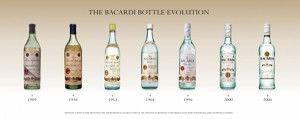
Bacardi bottles evolution – click to enlarge

Bacardi Bat evolution – click to enlarge
“I had an idea of what this rum should be and so did the other master blenders, so we tried to come up with one single Bacardi rum that would be good for all of us. And I think that if it is good for us, I think it will be good for everybody,” said Emilio Bacardí Bravo, Bacardi Family master blender.
The MMXII Vintage is described as “a highly aromatic, full-bodied and generous rum with a mellow flavor.” It is said to have an expansive nose with tropical fruits and sweet floral aromas, balanced with soft vanilla and a smooth oak character and enriched with notes of sweet Caribbean honey and fragrant fruits leading to a “long, pleasing finish with a smooth background of oak.”
The hand-blown crystal decanter was designed to represent El Coco, the coconut palm planted at the entrance of the first company distillery in Santiago de Cuba by the founder’s son 150 years ago. Etched onto the crystal decanter, next to the hand-pressed red crystal bat image, are the coordinates of 20 01 48.69N 075 49 56.86W that mark the birth place of the company rum in Santiago de Cuba. The decanter also features a map of the Caribbean pointing to the original distillery.
Founded on February 4, 1862, and family-owned for the past seven generations, Bacardi employs nearly 6,000 people, manufactures its brands at 27 facilities in 16 markets on four continents, and sells in more than 150 countries.
Posted by Elena del Valle on March 30, 2012
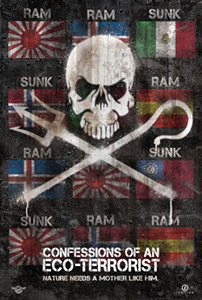
Confessions of an Ecoterrorist film poster
Video, photos: Peter Jay Brown, Blue Rage Media & Ignition Creative, Kelsey Stevens
Where documentaries often adopt a slow pace side by side with a serious and even somber tone Confessions of an Ecoterrist, a 90-minute docu-homage to the Sea Sheppard, its captain and crew and their exploits, manages to address a topic the film makers are obviously passionate about (30 years of activism attests to that) with a light tone, self deprecating humor and an undertone of incredulity, is fast paced and action packed, for a documentary. Completed in 2011, Confessions of an Eco-Terrorist Nature Needs a Mother Like Him is dedicated to journalist Bob Hunter and contains footage from 1977-2010. SnagFilms, a distributor of independent films on digital platforms, is releasing the feature documentary in the United States for pay-on-demand purchase on Earth Day, April 22, 2012. Click on the play button below to watch a trailer of the film.
The organization’s seaborne positive activism activities over 30 years are summarized and shared in a first hand one sided, account, by Peter Jay Brown, director, activist and longest serving Sea Shepherd crew member. He tells of the exploits, successes and disappointments of Captain Paul Watson and the Sea Shepherd Conservation Society, the stars of Whale Wars, Animal Planet’s Emmy-nominated series. The narrator’s admiration for Watson and the crew is evident.

Baby seal scene from the film
He peppers his narration with humor. For example, early on he explains that the organization relies on the work and support of volunteers aboard including many vegans. “A race of highly dedicated people; healthy, strong and perpetually pissed off,” he says of them. At the same time, he explains volunteers are not on a pleasure cruise and illustrates the hardships they endure such as constant seasickness and limited access to comforts such as showers (once a week). Watson he says is “a brilliant tactician and strategist with uncanny good luck.”
“Many young people today are losing hope. ‘Why bother? Nothing changes!’ they might say. Well I am here to say that change starts with everyone of us and those of us who are determined actually get things done. Get off the couch and get out there and make a positive difference. I did, so can you,” said Brown when asked to comment on the goal of the film.
During the society’s voyages the crew engaged in dramatic conflict including the boarding of ships, arrests (of the captain by the Canadian government, for example), being fired upon by a multimillion dollar vessel of the Norwegian Navy, boarding by an Ecuadorean admiral and successfully ramming and/or sinking illegal whaling and fishing vessels around the globe. According to promotional materials, the group is credited with stopping drift-netting worldwide and saving the lives of millions of marine wildlife.
Most of the film takes place on board or near a Sea Sheppard vessel, in the high seas and coastal areas of the United States, Canada, Antarctica, Faeroe Islands, Norway, Japan, and Galapagos islands of Ecuador. Among other things it includes images of the bloody killing of harp seal and the blood smeared faces of the seal “hunters.”
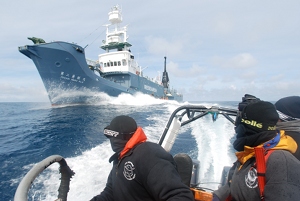
A scene from the film
The film was released in German speaking countries in December 2011 and is available there in cinemas and on DVD. In the United States, it is scheduled to become available in the VOD (video on demand) sections of cable networks, iTunes, Hulu-Plus, Amazon, and NetFlix in the coming weeks. The price is being determined. DVDs should be available in late April 2012, according to a spokesperson.
Established in 1977, the Sea Shepherd Conservation Society (SSCS) is an international non-profit, marine wildlife conservation organization with a stated mission “to end the destruction of habitat and slaughter of wildlife in the world’s oceans in order to conserve and protect ecosystems and species.” Toward this end Sea Shepherd uses “innovative direct-action tactics to investigate, document, and take action when necessary to expose and confront illegal activities on the high seas.” SnagFilms features free, sponsor-supported, on demand viewing of more than 3,000 award-winning, fiction and non-fiction titles. SnagFilms’ curated collection is available on its own site and a digital network of more than 110,000 affiliated sites and webpages.
Posted by Elena del Valle on February 27, 2012

Orly Wahba, CEO, Life Vest Inside
Photo: Vicki Ades
A podcast interview with Orly Wahba, founder and chief executive officer of Life Vest Inside, is available in the Podcast Section of Hispanic Marketing & Public Relations, HispanicMPR.com. During the podcast, she discusses her organization with Elena del Valle, host of the HispanicMPR.com podcast.
After completing her graduate studies in Jewish History from Touro College Orly dedicated ten years to work with tweens and teens and at charities in her community. Since 2004, she has been an educator for Middle School at the Yeshivah of Flatbush. Orly strives to incorporate ideas of kindness, love and respect in the hearts and minds of her students. She is fond of saying, “Kindness, don’t just do it live it!”
To listen to the interview, scroll down until you see “Podcast” on the right hand side, then select “HMPR Orly Wahba” click on the play button below or download the MP3 file to your iPod or MP3 player to listen on the go, in your car or at home. To download it, click on the arrow of the recording you wish to copy and save it to disk. The podcast will remain listed in the February 2012 section of the podcast archive.
To watch the video click on the play button in the video player below.
Posted by Elena del Valle on August 15, 2011
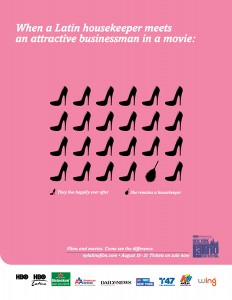
NYILFF Wing 2011 ad – click to enlarge
Photos, video: Wing
Hoping to attract English speaking New York City residents between 25 and 45 years of age to its twelfth annual event the organizers of the 2011 New York International Latino Film Festival (NYILFF) launched a new ad campaign the first week of August created to highlight a difference between movies and films by ribbing Hollywood movie cliches. The campaign with an estimated $50,000 in production costs and as much as one million dollars in paid and pro bono placements, was shot in Argentina with post production work in the United States. Scroll down to watch an ad.
The campaign emphasizes the shortage of Latinos in mainstream movies as well as the idea that Latino films concentrate on life compared to the “larger than life” abundant in blockbusters by showcasing stereotypical concepts like: The number of shots a six-round revolver can take in a movie without reloading, what happens in movies when a Latina housekeeper meets an attractive businessman, the names of gardeners in movies, and what happens in horror movies when a girl tries to get in a car.
TV and in-cinema ads, titled Asteroid, Dynamite, Fruit Stand Guy and Man in the Mirror, were produced by Wing, a New York ad agency, on a pro bono basis with the help of Academy Award winning Argentinean Production Company Puenzo Hermanos. The film festival staff believe the event’s audience consume a variety of media and love New York “for its energy and for everything it has to offer” and “define themselves as adventure-seekers and search out new and interesting experiences to fill their social calendar.”
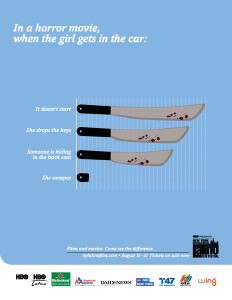
NYILFF Wing 2011 ad – click to enlarge
Each spot in the 2011 campaign makes fun of stereotypical Hollywood movie characters and ideas, and includes the tagline “Films and movies. Come see the difference.” In addition to TV, there are eight print and out-of-home ads in English and Spanish. The campaign seeks to reach “a broader audience with a commentary on the simplistic nature of Hollywood films, rather than an overtly Hispanic approach,” according to promotional materials.
Wing also created agency promotional material in-cinema and print that encourages people to let their Latino out. The in-cinema spot, intended to be “a whimsical and light-hearted effort” that shows an “un-Latin looking thin man” growing a thick mustache and liking it, attempts to emphasize the Hispanic influence on the mainstream market. Fifteen staff, led by Cionin Lorenzo, Elizabeth Gardner, Calixto Chinchilla, dedicated six months to the campaign production the success of which will be measured through ticket sales and on-line views. Festival staff anticipate 25,000 attendees at this year’s events.
The campaign was launched in NBC/Telemundo, HBO, Time, Out New York, Latina Magazine and the New York Daily News. In addition to the ads, the festival has active Facebook and Twitter pages where the new ads have been heavily promoted, a spokesperson indicated when asked about online placement of the ad campaign. The festival website was revised to coincide with the look and feel of the campaign. Also, the film festival independently created banner ads with geo-targeted placement on Hispanic websites. No information was available on which sites exactly.
The New York International Latino Film Festival strives to showcase the works of emerging Latino filmmakers in the United States and Latin America. This year’s festival run August 15-21 in various New York City theaters.

































